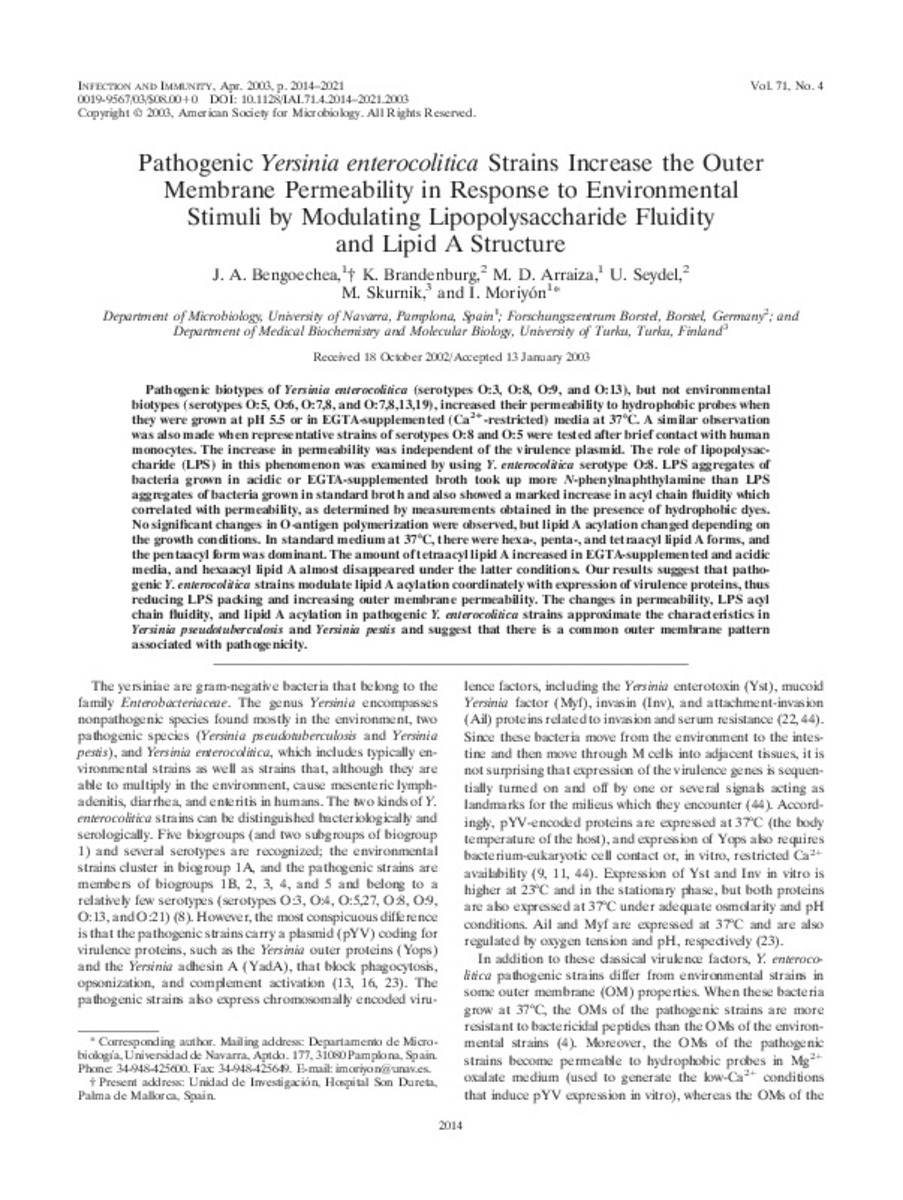Full metadata record
| DC Field | Value | Language |
|---|---|---|
| dc.creator | Bengoechea, J.A. (José A.) | - |
| dc.creator | Brandenburg, K. (Klaus) | - |
| dc.creator | Arraiza, M.D. (M. D.) | - |
| dc.creator | Seydel, U. (U.) | - |
| dc.creator | Skurnik, M. (M.) | - |
| dc.creator | Moriyon, I. (Ignacio) | - |
| dc.date.accessioned | 2013-06-25T09:53:46Z | - |
| dc.date.available | 2013-06-25T09:53:46Z | - |
| dc.date.issued | 2003 | - |
| dc.identifier.citation | Bengoechea JA, Brandenburg K, Arraiza MD, Seydel U, Skurnik M, Moriyon I. Pathogenic Yersinia enterocolitica strains increase the outer membrane permeability in response to environmental stimuli by modulating lipopolysaccharide fluidity and lipid A structure. Infect Immun 2003 Apr;71(4):2014-2021. | es_ES |
| dc.identifier.issn | 0019-9567 | - |
| dc.identifier.uri | https://hdl.handle.net/10171/29430 | - |
| dc.description.abstract | Pathogenic biotypes of Yersinia enterocolitica (serotypes O:3, O:8, O:9, and 0:13), but not environmental biotypes (serotypes O:5, O:6, O:7,8, and O:7,8,13,19), increased their permeability to hydrophobic probes when they were grown at pH 5.5 or in EGTA-supplemented (Ca2+-restricted) media at 37 degreesC. A similar observation was also made when representative strains of serotypes O:8 and O:5 were tested after brief contact with human monocytes. The increase in permeability was independent of the virulence plasmid. The role of lipopolysaccharide (LPS) in this phenomenon was examined by using Y. enterocolitica serotype O:8. LPS aggregates of bacteria grown in acidic or EGTA-supplemented broth took up more N-phenylnaphthylamine than LPS aggregates of bacteria grown in standard broth and also showed a marked increase in acyl chain fluidity which correlated with permeability, as determined by measurements obtained in the presence of hydrophobic dyes. No significant changes in O-antigen polymerization were observed, but lipid A acylation changed depending on the growth conditions. In standard medium at 37 degreesC, there were hexa-, penta-, and tetraacyl lipid A forms, and the pentaacyl form was dominant. The amount of tetraacyl lipid A increased in EGTA-supplemented and acidic media, and hexaacyl lipid A almost disappeared under the latter conditions. Our results suggest that pathogenic Y. enterocolitica strains modulate lipid A acylation coordinately with expression of virulence proteins, thus reducing LPS packing and increasing outer membrane permeability. The changes in permeability, LPS acyl chain fluidity, and lipid A acylation in pathogenic Y. enterocolitica strains approximate the characteristics in Yersinia pseudotuberculosis and Yersinia pestis and suggest that there is a common outer membrane pattern associated with pathogenicity. | es_ES |
| dc.language.iso | eng | es_ES |
| dc.publisher | American Society for Microbiology | es_ES |
| dc.rights | info:eu-repo/semantics/openAccess | es_ES |
| dc.subject | Pseudomonas-aeruginosa | es_ES |
| dc.subject | Hydrophobic permeants | es_ES |
| dc.subject | Brucella abortus | es_ES |
| dc.subject | Virulence | es_ES |
| dc.subject | Peptides | es_ES |
| dc.subject | Pseudotuberculosis | es_ES |
| dc.subject | Temperature | es_ES |
| dc.subject | Resistance | es_ES |
| dc.subject | Pestis | es_ES |
| dc.subject | Gene | es_ES |
| dc.title | Pathogenic Yersinia enterocolitica strains increase the outer membrane permeability in response to environmental stimuli by modulating lipopolysaccharide fluidity and lipid A structure | es_ES |
| dc.type | info:eu-repo/semantics/article | es_ES |
| dc.type.driver | info:eu-repo/semantics/article | es_ES |
| dc.identifier.doi | http://dx.doi.org/10.1128/IAI.71.4.2014-2021.2003 | es_ES |
Files in This Item:
Statistics and impact
Items in Dadun are protected by copyright, with all rights reserved, unless otherwise indicated.






